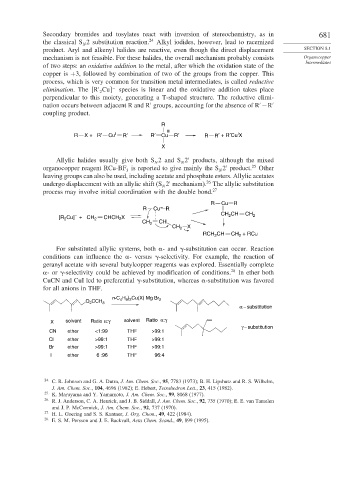Page 705 - Advanced Organic Chemistry Part B - Reactions & Synthesis
P. 705
Secondary bromides and tosylates react with inversion of stereochemistry, as in 681
the classical S 2 substitution reaction. 24 Alkyl iodides, however, lead to racemized
N
product. Aryl and alkenyl halides are reactive, even though the direct displacement SECTION 8.1
mechanism is not feasible. For these halides, the overall mechanism probably consists Organocopper
Intermediates
of two steps: an oxidative addition to the metal, after which the oxidation state of the
copper is +3, followed by combination of two of the groups from the copper. This
process, which is very common for transition metal intermediates, is called reductive
elimination. The R Cu
− species is linear and the oxidative addition takes place
2
perpendicular to this moiety, generating a T-shaped structure. The reductive elimi-
nation occurs between adjacent R and R groups, accounting for the absence of R −R
coupling product.
R
I
R X + R′ Cu I R′ R′ Cu III R′ R R ′ + R′Cu X
X
Allylic halides usually give both S 2 and S 2 products, although the mixed
N N
organocopper reagent RCu-BF is reported to give mainly the S 2 product. 25 Other
3 N
leaving groups can also be used, including acetate and phosphate esters. Allylic acetates
26
undergo displacement with an allylic shift (S 2 mechanism). The allylic substitution
N
process may involve initial coordination with the double bond. 27
R Cu R
–
R Cu R
CH CH CH
–
[R Cu] + CH 2 CHCH 2 X 2 2
2
CH 2 CH
CH 2 X
CH CH + RCu
RCH 2 2
For substituted allylic systems, both - and -substitution can occur. Reaction
conditions can influence the - versus -selectivity. For example, the reaction of
geranyl acetate with several butylcopper reagents was explored. Essentially complete
-or -selectivity could be achieved by modification of conditions. 28 In ether both
CuCN and CuI led to preferential -substitution, whereas -substitution was favored
for all anions in THF.
H ) Cu(X) Mg Br
n-C 4 9 2 2
O CCH 3
2
α − substitution
X solvent Ratio α:γ solvent Ratio α:γ
γ − substitution
CN ether <1:99 THF >99:1
Cl ether >99:1 THF >99:1
Br ether >99:1 THF >99:1
I ether 6 :96 THF 96:4
24 C. R. Johnson and G. A. Dutra, J. Am. Chem. Soc., 95, 7783 (1973); B. H. Lipshutz and R. S. Wilhelm,
J. Am. Chem. Soc., 104, 4696 (1982); E. Hebert, Tetrahedron Lett., 23, 415 (1982).
25
K. Maruyama and Y. Yamamoto, J. Am. Chem. Soc., 99, 8068 (1977).
26
R. J. Anderson, C. A. Henrick, and J. B. Siddall, J. Am. Chem. Soc., 92, 735 (1970); E. E. van Tamelen
and J. P. McCormick, J. Am. Chem. Soc., 92, 737 (1970).
27 H. L. Goering and S. S. Kantner, J. Org. Chem., 49, 422 (1984).
28
E. S. M. Persson and J. E. Backvall, Acta Chem. Scand., 49, 899 (1995).

